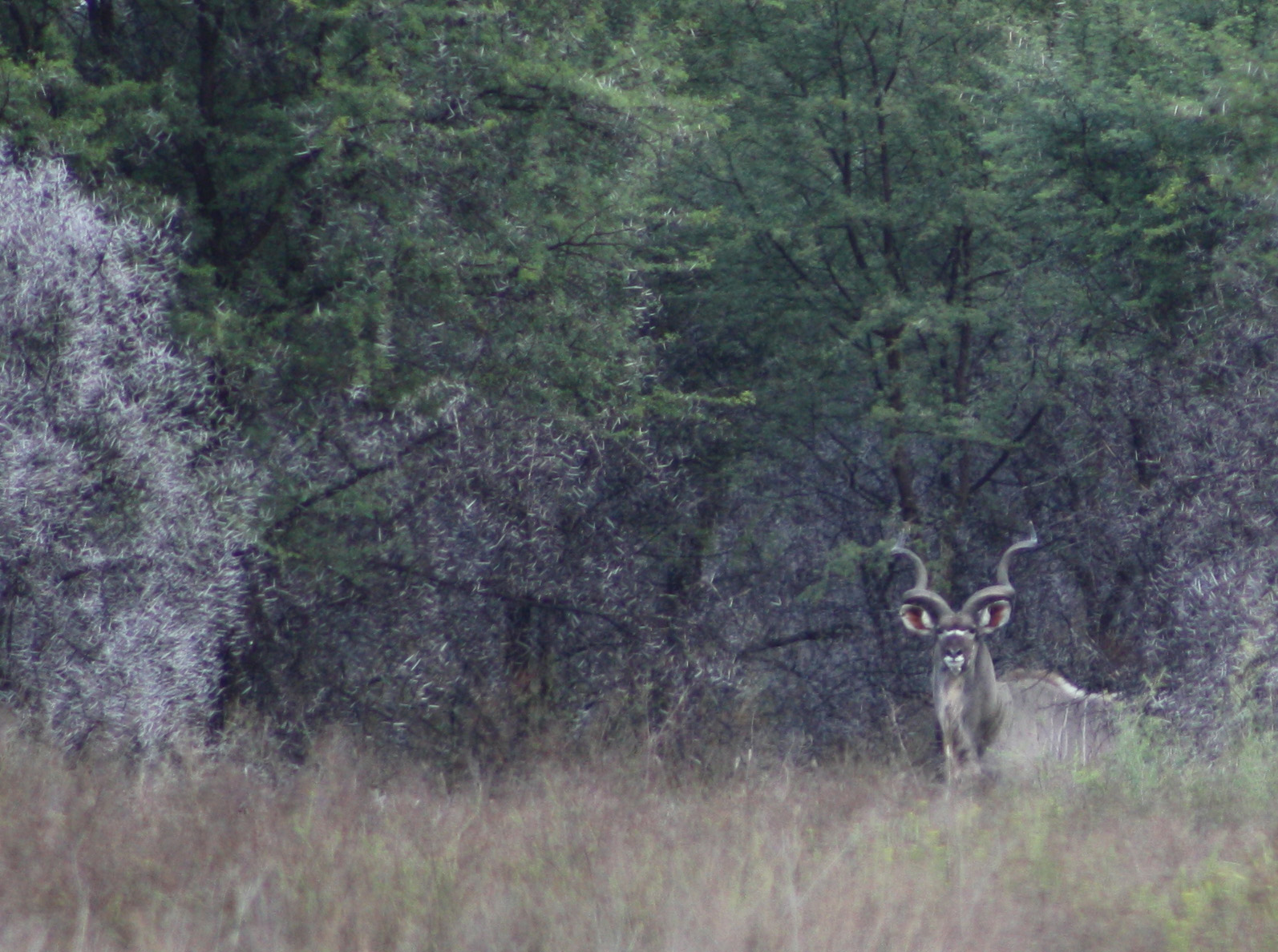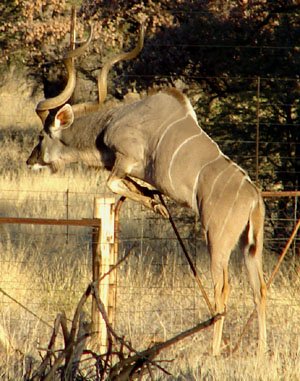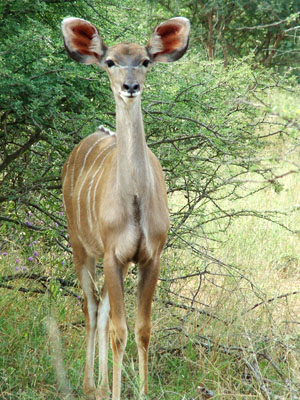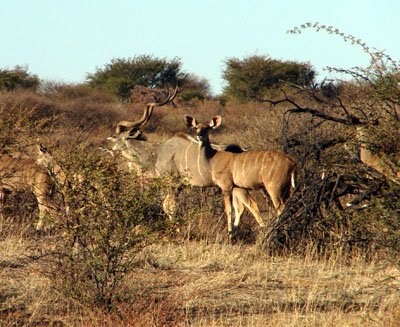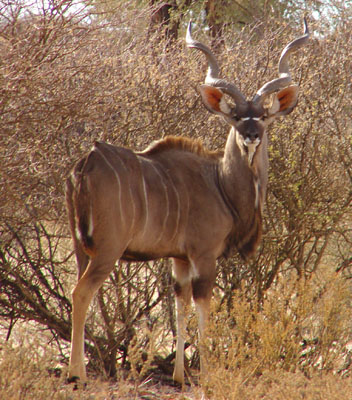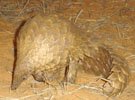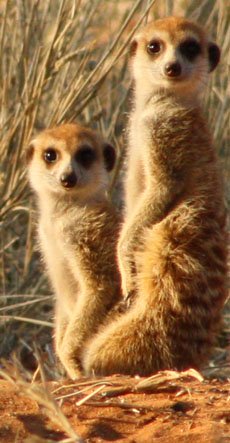For more information about our hunting safaris, don’t hesitate to reach out and contact us!
Greater Kudu Hunting
in Namibia
Namibia's moniker as "the country of the greater kudu" is well-earned. The animal's natural habitat of stark grey thorn bushes, rocky outcrops, and dry desert ridges is abundant in Namibia, providing a dramatic backdrop that highlights the beauty of this elusive and magnificent African antelope.
The greater kudu, known scientifically as "Tragelaphus strepsiceros" and also referred to as “koedoe,” “Grand koudou,” or “Großer Kudu,” is renowned and often regarded as the most aesthetically pleasing among the tragelaphine antelopes, which include species like the bongo, eland, nyala, bushbuck, and sitatunga.
Description
The towering and regal mammals of southern Africa stand at a shoulder height of 100 to 160 cm (3.2 to 5.2 ft) and have a weight range of 120 to 315 kg (264 to 787 lb). They sport short, sleek coats that can range from a tan-grey to a bluish-grey hue. As males age, they tend to become greyer, with their necks darkening during the breeding season.
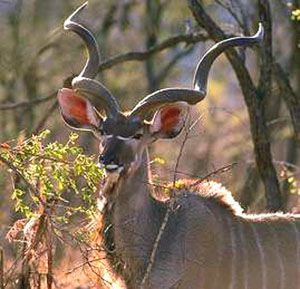
Both male and female specimens exhibit numerous white markings, including 6-10 vertical stripes along their flanks, a chevron between the eyes, and spots on the cheeks. They all possess a short, erect mane running from the crown of the head to the shoulders, continuing beneath along the throat. The bushy tail, tipped in black, is white on the underside. When alarmed, they curl the tail over the back, exposing the white to serve as a visual signal for the herd to follow through dense vegetation.
Only the males boast long, spiraled horns that form up to three elegant twists and average 51 inches in length. These horns are rarely used for defense against predators and do not hinder movement in forested areas. Kudu bulls simply raise their chins and rest the horns along their backs to navigate through thick brush.
Habitat and Diet
Greater Kudus inhabit the arid regions of Eastern and Southern Africa. They feed on a diverse range of bushes, herbs, and trees. The low to medium-height woody vegetation offers them sustenance as well as refuge.
Bulls tend to feed at full stretch more often than cows and may use their horns to break down branches when leaves are too high to reach.
During dry periods, they consume wild watermelons and other fruits for hydration. The lesser kudu relies less on water sources compared to the greater kudu. In areas where farming encroaches on their habitats, kudus occasionally visit plantations and vegetable gardens at night.
Kudus are renowned for their remarkable jumping abilities. They can effortlessly leap over a 2-meter (6.56 feet) fence, while a 3-meter (9.84 feet) barrier can be spontaneously cleared. Under stress, these powerful jumpers are capable of reaching heights up to 3.5 meters (11.48 feet).
Behavior
Kudu are normally more active in the early morning and evening, but become nocturnal where disturbed. During the heat of the day in the Kalahari, kudu can be overlooked easily since they spend nearly all their time hidden under the overhang of trees. Their color gives them excellent camouflage!
These mammals live in small herds although we have seen large numbers of them together on our ranch. In the mating season, males and females occur together. The sexes are separate the rest of the time and during these separations, the bulls stay singular or form bachelor groups. Females, calves and subadults form small family herds.
Bulls are very secretive when they are alone and will stand motionless in bushes and under trees to avoid detection. Then only the very experienced human eyes can see them.
When disturbed, a kudu will usually stop and listen to assess the situation and then move away quietly or dash off after giving a loud, sharp alarm bark, which is regarded as the loudest of all the antelope species.
When a kudu is stalked, this loud and strange-sounding bark often surprises people. Social grooming occurs in both family and bachelor groups.
Dominance among bulls is based on size and displays of fighting ability. Fights involve lunging, clashing of horns and wrestling with locked horns that often results in death for both the competitors.
Reproduction
Kudu males are sexually mature at three years and first breed at six years, while females first calve at two to three years. Prime bulls develop massive neck muscles during the mating season due to their fighting, thrashing of bushes and digging up of soil to display their dominance to females.
When a bull has access to females, he checks the females’ reproductive condition by sniffing and flehmen of her urine and genitals.
As a female comes into heat, the dominant bull will mate only once with her since he chooses the best time for conception from the smell of her urine.
Single calves are born after a gestation period of 210 to 225 days and are hidden in close cover by their mothers, who stay with her newborn for the first day. After that she will return to her herd and visits the calf to suckle it three to five times a day. The calf lies out for its first one to two months and weans at six months.
The horns of kudu start growing at five months. Kudu have a lifespan of ±15 years.
Kudu in the Kalahari Region
Long-time ranchers say that kudus were not originally present in the Kalahari region. However, since humans established wells, the greater kudu has expanded into territories within this semi-desert that were once too arid for them.
Our father, Hendrik, erected a tall fence around the huge terrritory of Uitspan Ranch in the early years following 1980. This proved to be an effective method for the conservation of kudus in the Kalahari since they were better protected against predators and droughts.
Greater Kudu numbers increased over the following years and we and former visitors to Uitspan were privileged to enjoy, respect and adore the sublime beauty and special hiding skills of this “grey ghost of the bush” (as they were called by Ernest Hemingway in his classic book The Green Hills of Africa).
Greater Kudu Hunting in Namibia
Just like Hemingway, most hunters experience a passion and a wish to obtain this dream trophy since man are often outwitted by the alertness and fantastic sense of hearing of the greater Kudu.
Steve's Kudu Hunt in the Kalahari
Taking home a kudu trophy symbolizes a transformative experience, reflecting the qualities and beauty of this unique animal, native to the Kalahari, as crafted by the Almighty God.
Have a look at another Greater Kudu hunt with us in Namibia.
Meaning of "Uitspan"
'Uitspan' is an Afrikaans word that means place of rest.
When the Boer settlers moved inland in Southern Africa in the 1800's, they used ox carts. When they found a spot with game, water and green grass, they arranged their ox carts into a circular laager for protection against wild animals and stopped for a rest.
They referred to such an action of relaxation for man and beast, as Uitspan.
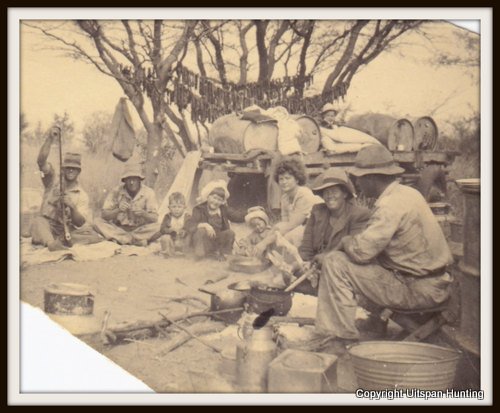
(Picture above of our ancestors.)
Did you know?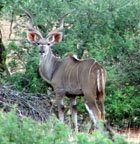 Greater Southern Kudus are famous for their ability to jump high fences. A 2 m (6.56 ft) fence is easily jumped while a 3 m (9.84 ft) high fence is jumped spontaneously. These strong jumpers are known to jump up to 3.5 m (11.48 ft) under stress. |
to read about my experience...
Did you know? Some animals have one sense more than man!The flehmen response is a particular type of curling of the upper lip in ungulates, felids and many other mammals. This action facilitates the transfer of pheromones and other scents into the vomeronasal organ, also called the Jacobson's Organ. Some animals have one sense more than man!The flehmen response is a particular type of curling of the upper lip in ungulates, felids and many other mammals. This action facilitates the transfer of pheromones and other scents into the vomeronasal organ, also called the Jacobson's Organ.This behavior allows animals to detect scents (for example from urine) of other members of their species or clues to the presence of prey. Flehming allows the animals to determine several factors, including the presence or absence of estrus, the physiological state of the animal, and how long ago the animal passed by. This particular response is recognizable in males when smelling the urine of a females in heat. |
